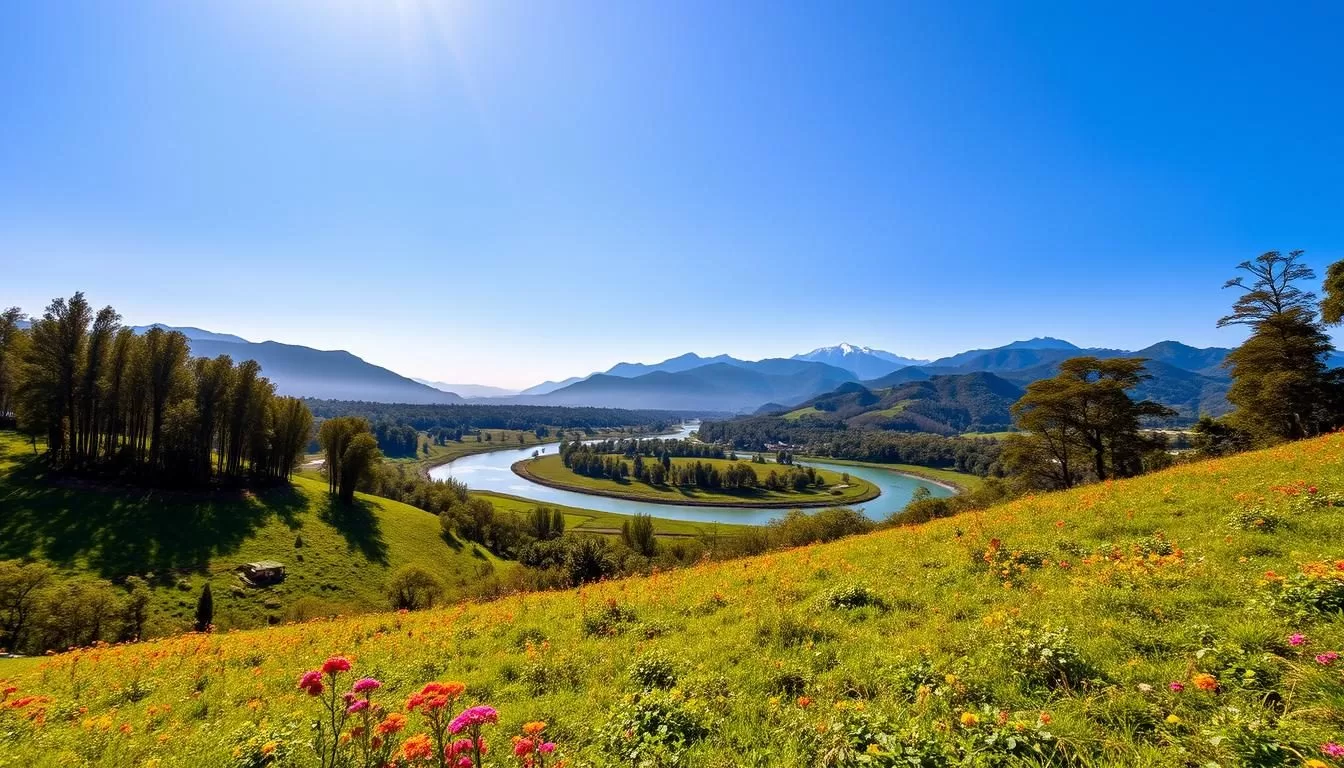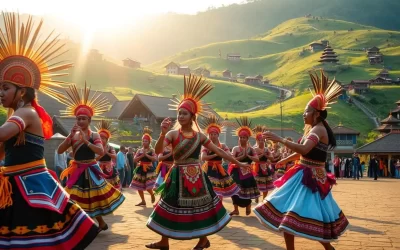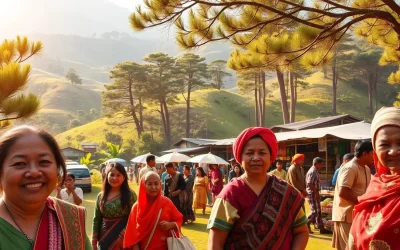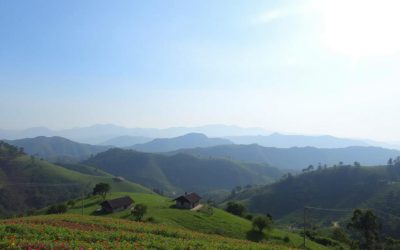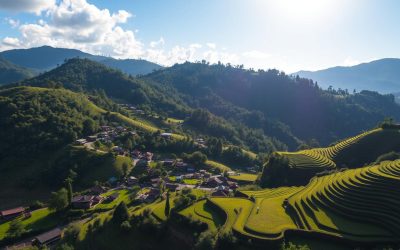✓ Accommodations✓ Flights✓ Rental Cars
Planning a trip to Nagaland but unsure when to go? Understanding the seasonal variations is crucial for a successful trip to this enigmatic state.
The best time to visit is divided into three main seasons: peak, moderate, and off-season. Winter is particularly inviting from October to February, with temperatures ranging from 4°C to 24°C, making it ideal to enjoy the vibrant Hornbill Festival in December.
You’ll experience a unique cultural experience with its indigenous tribes and distinct way of life. This guide will help you navigate the best time to visit based on weather patterns, cultural festivals, and outdoor activities, ensuring your trip is perfectly timed for your preferences.
Understanding Nagaland’s Climate and Seasons
Understanding Nagaland’s climate requires insight into its varied geography and the distinct seasons it experiences. Nagaland, a state in northeastern India, has a climate that is significantly influenced by its terrain.
Nagaland’s geography, with its rolling hills and mountains, contributes to its diverse weather patterns. The state’s elevation plays a crucial role in determining its temperatures and seasonal variations.
Geographic Influence on Weather Patterns
The unique geography of Nagaland results in a range of weather conditions across different months. The state’s terrain influences the climate, creating varied conditions across its regions.
| Geographic Feature | Influence on Climate |
|---|---|
| Hills and Mountains | Cooler temperatures, varied rainfall |
| Valleys | Warmer temperatures, foggy conditions |
Three Distinct Seasons Overview
Nagaland experiences three primary seasons: winter, summer, and monsoon. Each season brings distinct weather conditions, influencing the state’s climate and activities.
- Winter (October to February): Cool, dry conditions with temperatures between 4°C and 24°C.
- Summer (March to May): Rising temperatures, increasing humidity.
- Monsoon (June to September): Heavy rainfall, lush greenery.
Nagaland’s climate is thus characterized by its diverse geography and distinct seasons, making it a unique destination.
Winter Season: The Prime Time to Visit
The winter season is considered the best time to visit Nagaland due to its pleasant weather. During this period, the state is bustling with activity, attracting tourists from all over.
October to February Weather Conditions
Nagaland’s weather from October to February is characterized by cool temperatures and clear skies, making it ideal for outdoor activities.
Temperature Ranges and Rainfall Expectations
Temperatures during the winter months range from 10°C to 15°C, with minimal rainfall, ensuring a comfortable trip.
Why Winter is Considered Peak Tourist Season
Winter is peak tourist season in Nagaland due to the comfortable weather and numerous cultural events. Some of the key reasons include:
- The world-famous Hornbill Festival takes place during winter, showcasing Nagaland’s rich cultural heritage.
- Pleasant weather conditions make it easy to explore multiple destinations without the challenges of rain or extreme heat.
- Clear visibility enhances sightseeing and photography opportunities across Nagaland’s scenic landscapes.
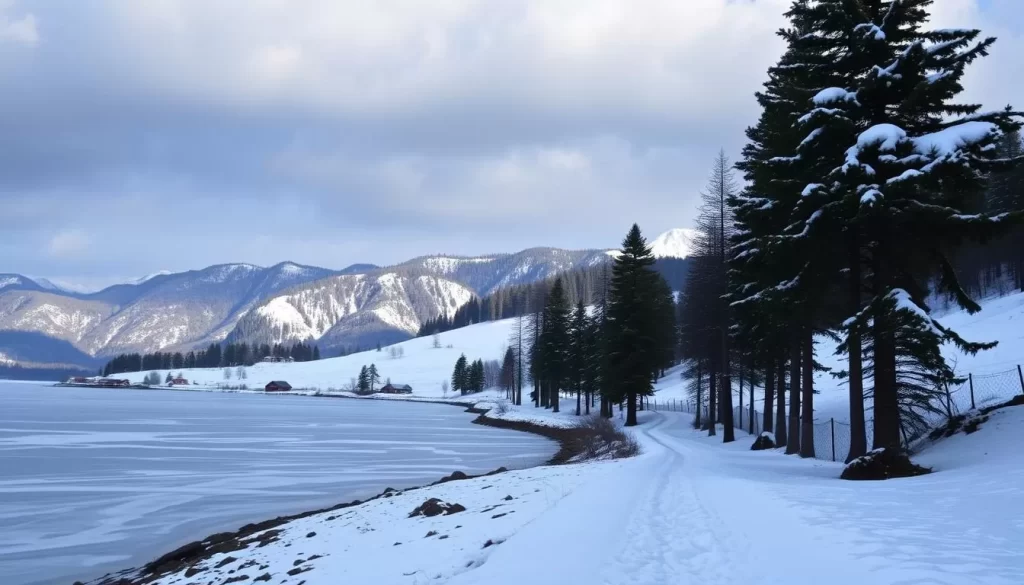
The Hornbill Festival Experience
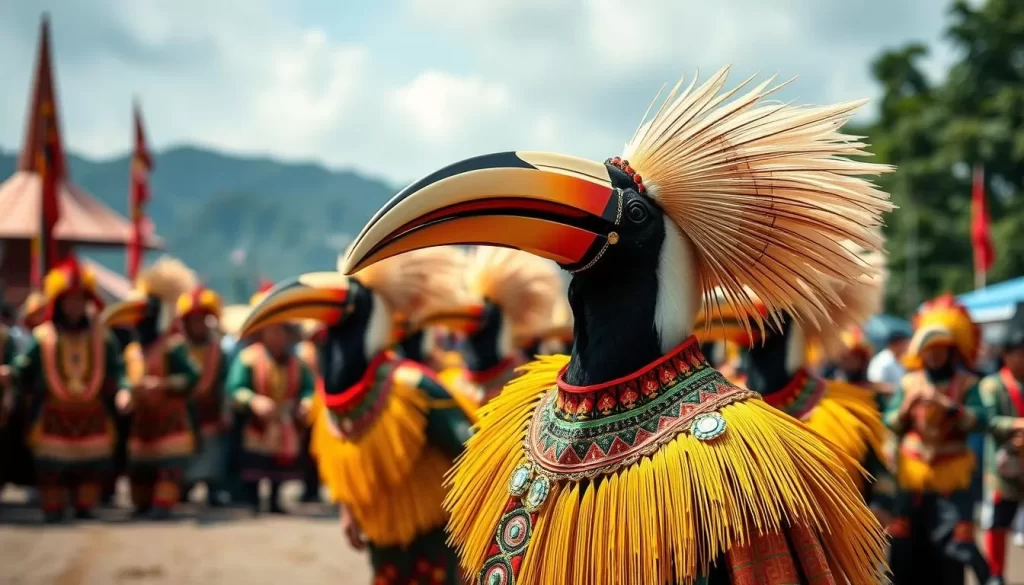
For a truly immersive cultural experience, consider visiting Nagaland during the Hornbill Festival. This spectacular event is a celebration of Nagaland’s rich heritage, featuring traditional dances, music, and art.
December’s Cultural Extravaganza
The Hornbill Festival, held in the first week of December, is a cultural extravaganza that attracts visitors from all over. It’s a time when the state comes alive with vibrant performances and festivities.
Planning Your Visit Around the Festival
To make the most of your trip to Nagaland during the Hornbill Festival, it’s essential to plan ahead. Here are some key considerations:
– Accommodation fills quickly, so booking at least 3-4 months in advance is crucial.
– Transportation requires careful planning, with flights to Dimapur and shared taxis to Kohima being the most common route.
– Festival passes can be purchased on-site, but arriving early each day helps secure good viewing positions.
– Combining your festival visit with trips to nearby villages provides a more comprehensive understanding of Naga culture.
– The weather during the festival is typically pleasant, with daytime temperatures around 15-20°C, but evenings can be chilly.
By planning your visit around the Hornbill Festival, you can experience the best of Nagaland’s culture and hospitality. Make sure to visit Nagaland at the right time to visit for an unforgettable experience.
Summer in Nagaland: March to May
Summer in Nagaland, spanning from March to May, brings a unique blend of adventure and cultural experiences. As the region transitions into warmer months, travelers can enjoy a mix of exciting activities and serene landscapes.
Temperature and Humidity Levels
During the summer, Nagaland experiences rising temperatures and increasing humidity. The average temperature ranges from 25°C to 30°C, making it warm but not extreme. However, the humidity levels rise significantly as the season progresses, especially towards May.
Pros and Cons of Summer Visits
Visiting Nagaland during the summer has its advantages and disadvantages. On the positive side, the summer offers significantly lower accommodation rates and fewer crowds at popular attractions compared to the winter high season. The blooming rhododendrons and orchids create spectacular landscapes, especially in April, providing unique photography opportunities.
| Aspect | Pros | Cons |
|---|---|---|
| Tourist Season | Fewer crowds, peaceful exploration | Some attractions may be less accessible |
| Accommodation | Lower rates | Limited options in remote areas |
| Activities | Adventure sports like trekking remain popular | Pre-monsoon showers can disrupt outdoor activities |
| Cultural Experiences | Local agricultural festivals and pre-monsoon celebrations | Increasing humidity and occasional heavy downpours |
When you plan your trip to Nagaland during the summer, it’s essential to pack accordingly. Bring waterproof gear and dress comfortably for the warm, wet weather. This will ensure that you’re prepared for the conditions and can make the most of your visit.
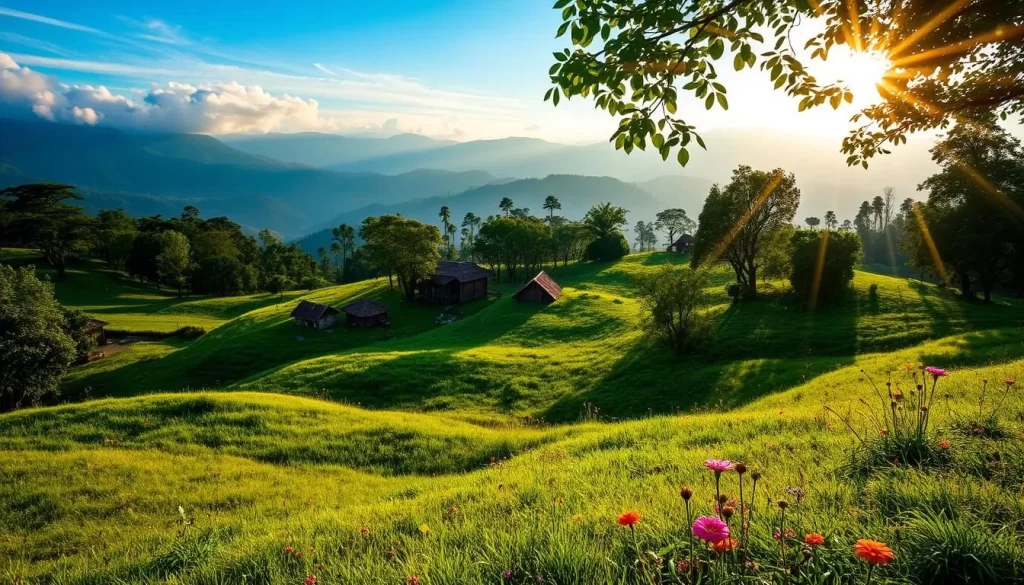
Overall, summer can be a great time to visit Nagaland if you’re looking for a more relaxed atmosphere and lower costs. Just be sure to plan ahead and pack appropriately for the weather conditions.
Monsoon Season: June to September
As the calendar flips to June, Nagaland plunges into its monsoon season, bringing with it a mix of challenges and breathtaking landscapes. This period, lasting until September, is characterized by significant rainfall that transforms the region.
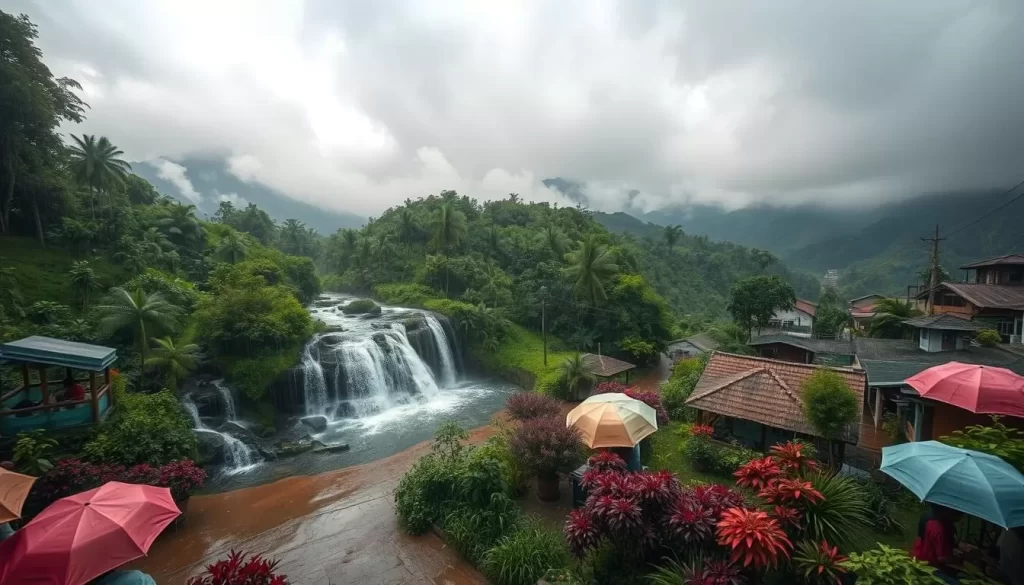
Rainfall Patterns and Intensity
The monsoon season in Nagaland is marked by heavy showers that are crucial for the region’s agricultural activities. The rainfall is not just a weather phenomenon but is deeply intertwined with the local culture and economy.
- The intensity of the rainfall can vary, with some areas experiencing heavier downpours than others.
- This period is vital for the region’s lush landscapes and greenery.
Navigating Nagaland During Rainy Months
Navigating Nagaland during the monsoon requires careful planning and flexibility. While the rain can make some aspects of travel challenging, it also offers unique opportunities to experience the region’s vibrant natural beauty.
- Waterproof gear is essential for travelers, including quality rain jackets and protective covers for electronics.
- Flexibility in travel plans is crucial, as weather conditions can change rapidly.
- Indoor activities like visiting museums and cultural centers become more appealing during this time.
Planning your trip during the monsoon season can be rewarding, with fewer tourists and lush landscapes making for a serene experience.
Nagaland, India: Best Months for a Weather-Savvy Trip
Understanding Nagaland’s monthly weather patterns is essential for planning a weather-savvy trip. The state’s climate varies significantly throughout the year, making some months more suitable for certain activities than others.
Optimal Months for Different Travel Priorities
If you’re looking for comfortable temperatures and minimal rainfall, the period from October to February is ideal. During these months, you can enjoy outdoor activities like trekking and sightseeing without the hindrance of harsh weather. For those interested in cultural experiences, December is a great time due to the Hornbill Festival.
Month-by-Month Weather Breakdown
Here’s a breakdown of what to expect:
- January: Enjoy cold mornings and mild afternoons with minimal rainfall.
- February: Slightly warmer with dry conditions, perfect for the Sekrenyi Festival.
- March: Warming trend with occasional light showers and blooming vegetation.
- April: Increasingly warm and humid with pre-monsoon showers.
- May through September: Heavy rainfall, with peak precipitation in July and August.
- October through December: Decreasing rainfall and temperatures, ideal for the Hornbill Festival in December.

By considering these factors, you can choose the best time for your visit based on your priorities, ensuring a memorable trip to Nagaland.
Key Festivals Beyond Hornbill
Nagaland’s cultural calendar is dotted with numerous festivals, each offering a unique glimpse into the state’s traditions and spirit. While the Hornbill Festival is a major draw, there are other significant celebrations that showcase the diversity and richness of Naga culture.
Sekrenyi Festival and Winter Celebrations
The Sekrenyi Festival, observed by the Angami tribe, is a significant event during the winter season. It involves rituals, feasting, and community activities that reflect the tribe’s heritage. Visiting during this time allows tourists to experience the authentic cultural practices of Nagaland.
Seasonal Tribal Festivals Worth Experiencing
Nagaland’s tribes celebrate various festivals throughout the year, each with its unique flavor and significance. Some of the notable ones include:
- The Aoling Festival in April, marking the new year with vibrant ceremonies and traditional dances.
- The Moatsu Festival in May, celebrating the completion of sowing with singing, dancing, and feasting.
- The Tuluni Festival in July, a celebration of abundance with rice beer and community meals.
- The Mongmong Festival in September, marking the end of the agricultural cycle with prayers for a good harvest.
These seasonal celebrations provide a deep dive into Nagaland’s rich heritage and offer tourists a chance to experience the local culture firsthand.
By planning your visit around these festivals, you can have a more immersive and enriching experience in Nagaland. Whether you’re interested in cultural heritage or simply looking for a unique travel experience, Nagaland’s festivals are sure to leave a lasting impression.
Trekking and Outdoor Adventures by Season
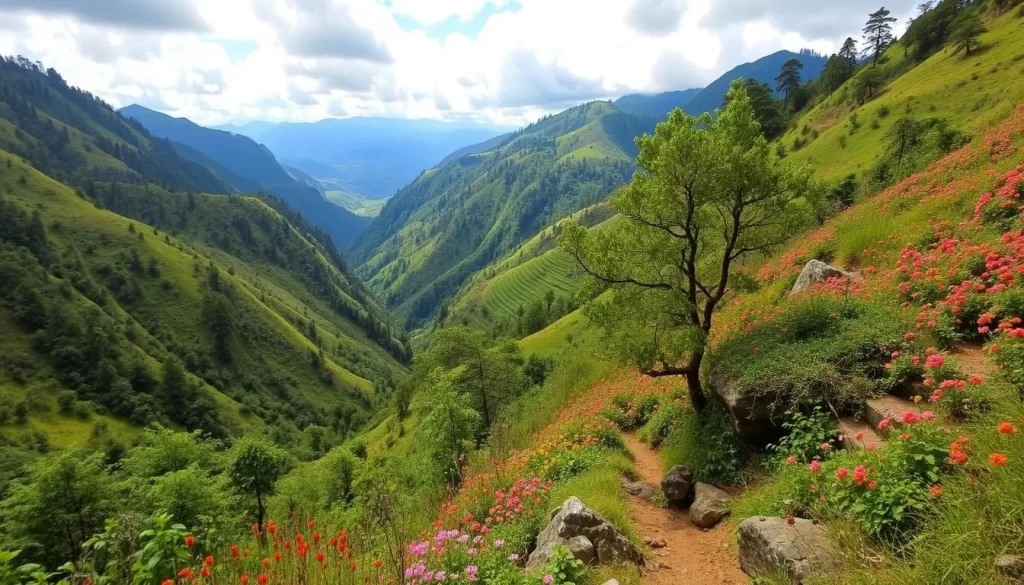
As the seasons change, Nagaland transforms into a haven for outdoor enthusiasts, offering a myriad of activities. The state’s diverse landscapes and climates make it an ideal destination for trekking and outdoor adventures throughout the year.
Best Hiking Trails and When to Explore Them
Nagaland is home to several breathtaking hiking trails, with the Dzukou Valley trek being one of the most popular. The best time to explore these trails is during winter (October to February), when the weather is cool and pleasant, making it ideal for trekking.
Seasonal Outdoor Activity Guide
The season plays a crucial role in determining the type of outdoor activities you can enjoy in Nagaland.
– Winter (October-February) offers ideal conditions for trekking, camping, bird watching, and wildlife photography.
– Early summer (March-April) is perfect for river activities like fishing and gentle rafting.
– The monsoon season (June-September) is best for waterfall visits and photography.
– Rock climbing and rappelling are best during the dry winter months.
– Mountain biking trails around Kohima and Dimapur are accessible during winter and early summer.
Some of the exciting places to visit include the Doyang River for river rafting and Intanki National Park for wildlife safaris. These places offer a unique experience, showcasing Nagaland’s rich biodiversity and natural beauty.
Wildlife Viewing Opportunities Throughout the Year
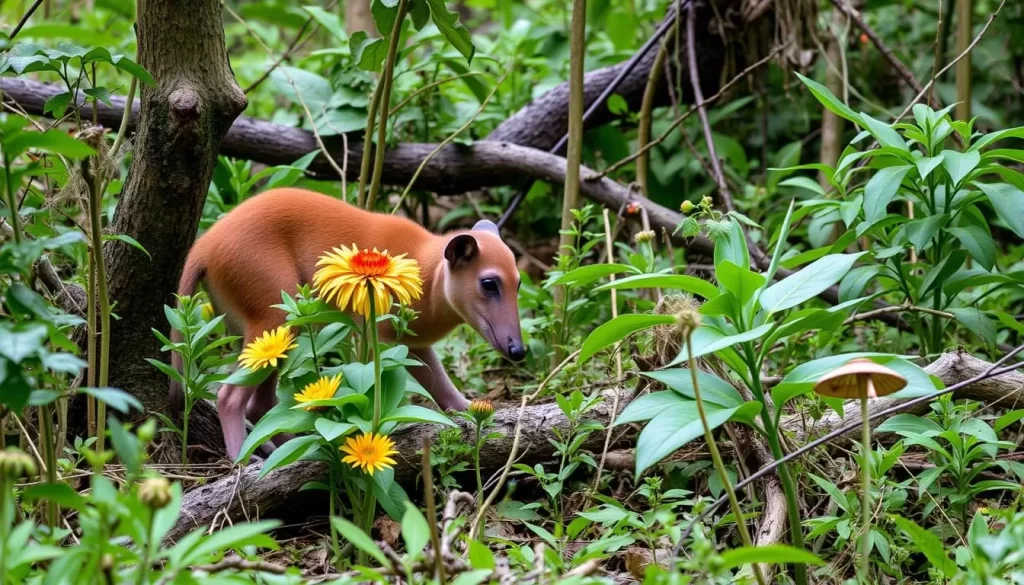
As you plan your trip to Nagaland, understanding the best time for wildlife viewing can enhance your overall experience. Intanki National Park, a haven for wildlife enthusiasts, offers diverse opportunities to spot various species throughout the year.
Optimal Wildlife Spotting Seasons
The region’s climate influences the behavior and visibility of its wildlife. Generally, the winter months (November to February) provide ideal conditions for spotting wildlife due to the dry undergrowth and clearer visibility.
Nature Photography Tips by Season
Nature photographers find that April-May offers stunning flowering landscapes, while September-October brings post-monsoon greenery. Each season requires different camera settings and equipment considerations.
Cultural Immersion: Tribal Villages and When to Visit
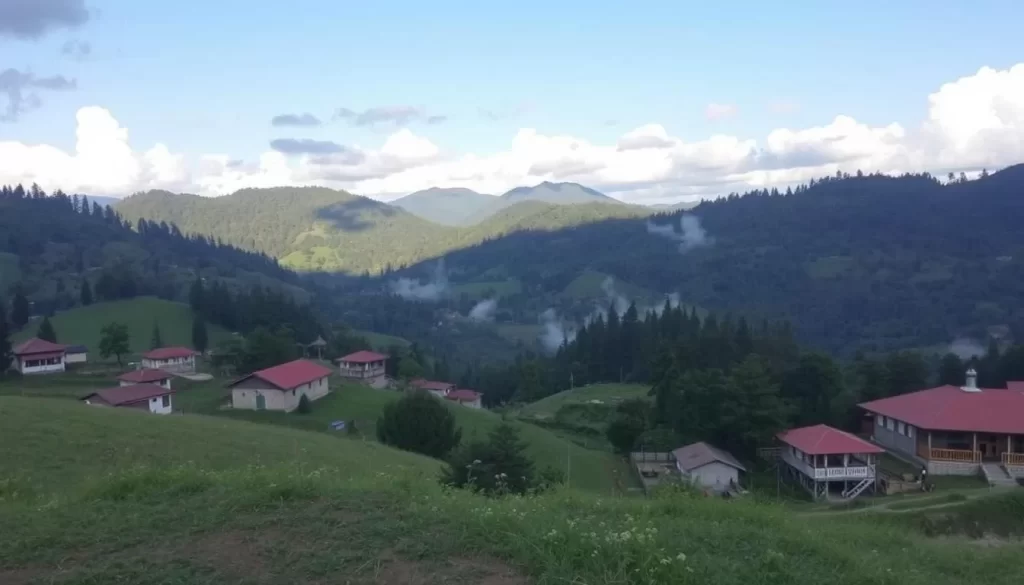
The tribal villages of Nagaland are best experienced by understanding the seasonal rhythms that govern local life and traditions. As you plan your visit, you’ll find that each season offers a unique window into the community’s activities, celebrations, and daily life.
Seasonal Variations in Cultural Experiences
Nagaland’s cultural landscape is deeply intertwined with its agricultural cycles. From field preparation to harvest festivals, the rhythm of farming dictates the pace of life in the tribal villages. For instance, during farming seasons, you can witness locals engaged in various agricultural activities that are both fascinating and educational.
In the summer months, the villages come alive with planting rituals and early crop maintenance. Communities work together in traditional cooperative systems, showcasing the strong social bonds that are characteristic of Nagaland’s tribes.
Agricultural Seasons and Community Activities
The monsoon season, which coincides with the peak agricultural activity, is a time of weeding, field maintenance, and preliminary harvests. Although tourist activity is relatively low during this period due to heavy showers, it’s an excellent time to experience the authentic, unhurried pace of rural life in Nagaland’s cities and villages.
Here’s a breakdown of what you can expect during different months:
– February and March: Field preparation and seed selection activities are in full swing.
– April through June: Planting rituals and early crop maintenance are the focus, with communities working together.
– July through September: Peak agricultural activity with weeding and preliminary harvests.
– October and November: Harvest festivals and community celebrations.
– December and January: Craft production, storytelling, and community building projects during the agricultural off-season.
By aligning your visit with these seasonal activities, you can have a more immersive and meaningful experience in Nagaland’s tribal villages.
Packing Essentials for Different Seasons
To make the most of your travel experience in Nagaland, understanding the packing essentials for different seasons is key. The state’s climate varies significantly throughout the year, making it crucial to be prepared.
Winter Wardrobe Necessities
During the winter months, it’s essential to pack warm clothing, including thermal layers and a good quality jacket to keep you cozy in Nagaland’s chilly weather conditions.
Summer Comfort Items
For summer visits, prioritize lightweight, breathable clothing that will help keep you cool in the heat. Comfortable footwear is also a must for exploring Nagaland’s scenic landscapes.
Monsoon Must-Haves
The monsoon season in Nagaland requires specific packing essentials, including waterproof gear like rain jackets and waterproof footwear to keep you dry. Additionally, consider packing quick-drying clothes and protective covers for your electronics and documents to safeguard against moisture damage.
- Waterproof rain jackets and pants for daily downpours
- Waterproof footwear for navigating wet terrain
- Dry bags or waterproof cases for protecting valuables
Being prepared for the conditions and potential disruptions due to weather will ensure a smoother trip.
Transportation Considerations by Season
Nagaland’s transportation infrastructure is heavily influenced by the season. Understanding these variations is crucial for planning a smooth and enjoyable trip.
Road Conditions Throughout the Year
The road conditions in Nagaland change significantly with the seasons. During the dry winter months, roads are generally in good condition, making travel relatively easy. However, the monsoon season brings challenging road conditions, with frequent landslides and disruptions.
Best and Worst Times for Internal Travel
The best time for internal travel within Nagaland is from November to February, when the weather is dry and road conditions are favorable. In contrast, July and August are the most challenging months due to heavy rainfall and potential landslides.
To give you a better understanding of the transportation considerations, here’s a summary:
| Season | Road Conditions | Transportation Reliability |
|---|---|---|
| Winter (Nov to Feb) | Good | High |
| Summer (Mar to May) | Fair | Moderate |
| Monsoon (Jun to Sep) | Poor | Low |
It’s also worth noting that during the Hornbill Festival in December, transportation demand increases significantly, requiring advance bookings. Pre-arranged transportation through tour operators can provide the most reliable option, especially for visitors unfamiliar with the region.
When traveling to Nagaland, it’s advisable to plan ahead, especially if you’re relying on public transportation or have a connecting flight through an Indian airport. Remember to collect your luggage, go through customs, and check it back in. Having pre-arranged transportation can save you from potential breakdowns or being stranded.
Conclusion
Nagaland is a versatile travel destination that beckons visitors throughout the year. Each season offers unique experiences, from the vibrant Hornbill Festival in winter to the lush landscapes during the monsoon. Whether you’re trekking in the cool months or finding great deals in spring, Nagaland has something for you. By understanding the seasonal variations, you can plan your trip according to your interests.
Plan your visit to Nagaland and discover its wonders, exploring places like Kohima and Dimapur. With its rich cultural heritage and stunning landscapes, Nagaland ensures a memorable journey.
The above is subject to change.
Check back often to TRAVEL.COM for the latest travel tips and deals.
